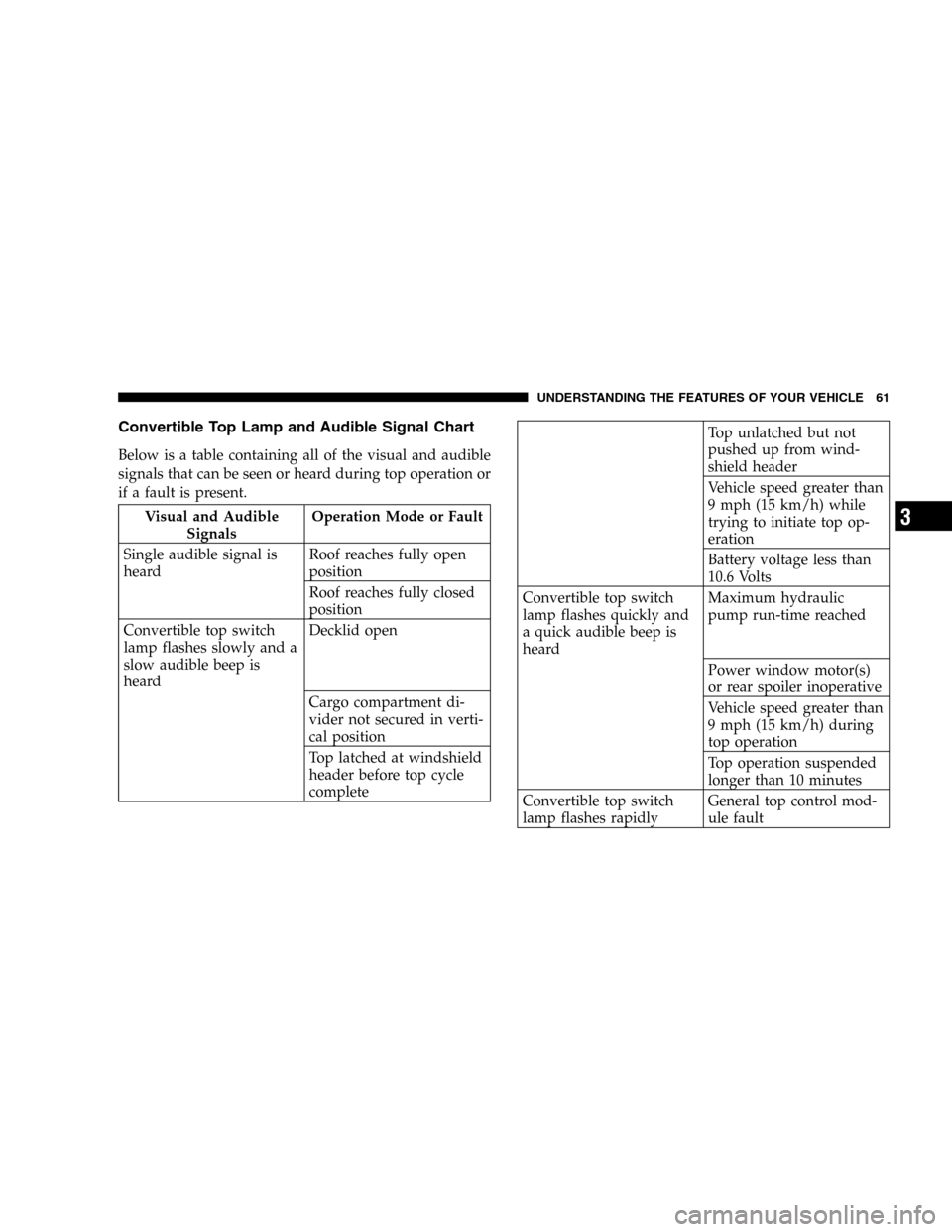Page 52 of 296

CONVERTIBLE TOP OPERATION
WARNING!
The convertible top does not provide the structural
protection that a reinforced metal roof does and the
fabric top cannot be expected to prevent the ejection
of the occupants of a vehicle in a collision. There-
fore, it is important that all occupants wear their seat
belts at all times when riding in a convertible.
Studies have shown that it is generally safer to
remain inside a vehicle during a collision than to be
ejected from the vehicle.
For safety reasons, the convertible top should only be
opened and closed when the vehicle is standing still. Top
operation is allowed up to a maximum of 9 mph (15
km/h). Above this speed, top operation will cease and an
audible warning will sound. The top operation can be
resumed after the vehicle is below the maximum speed
by pressing the convertible top switch again.
WARNING!
Before operating the switch for the convertible top,
make sure that no persons can be injured by the
moving parts (convertible top frame and tonneau
cover).
Hands must never be placed near the sport bar,
convertible top frame, upper windshield area, shelf
behind sport bar, or convertible top storage compart-
ment while the convertible top is being raised or
lowered. Serious personal injury may occur.
If potential danger exists, release the convertible top
switch. This immediately interrupts the raising or
lowering procedure. You then can operate the con-
vertible top switch to raise or lower the convertible
top away from the danger zone.
52 UNDERSTANDING THE FEATURES OF YOUR VEHICLE
Page 61 of 296

Convertible Top Lamp and Audible Signal Chart
Below is a table containing all of the visual and audible
signals that can be seen or heard during top operation or
if a fault is present.
Visual and Audible
SignalsOperation Mode or Fault
Single audible signal is
heardRoof reaches fully open
position
Roof reaches fully closed
position
Convertible top switch
lamp flashes slowly and a
slow audible beep is
heardDecklid open
Cargo compartment di-
vider not secured in verti-
cal position
Top latched at windshield
header before top cycle
complete
Top unlatched but not
pushed up from wind-
shield header
Vehicle speed greater than
9 mph (15 km/h) while
trying to initiate top op-
eration
Battery voltage less than
10.6 Volts
Convertible top switch
lamp flashes quickly and
a quick audible beep is
heardMaximum hydraulic
pump run-time reached
Power window motor(s)
or rear spoiler inoperative
Vehicle speed greater than
9 mph (15 km/h) during
top operation
Top operation suspended
longer than 10 minutes
Convertible top switch
lamp flashes rapidlyGeneral top control mod-
ule fault
UNDERSTANDING THE FEATURES OF YOUR VEHICLE 61
3
Page 136 of 296

▫Electronic Stability Program (ESP).........152
▫Synchronizing ESP....................153
▫ESP Control Switch....................154
▫Anti-Lock Brake System (ABS)............155
▫Brake Pad Break-In....................158
�Power Steering........................158
�Tire Safety Information..................159
�Tires—General Information...............159
▫Tire Pressure.........................159
▫Tire Inflation Pressures.................160
▫Radial-Ply Tires......................162
▫Tire Spinning........................162
▫Tread Wear Indicators..................163
▫Replacement Tires.....................163
▫Alignment And Balance.................165
�Tire Pressure Monitor System (If Equipped). . 165▫General Information...................167
�Tire Chains...........................167
�Original Equipment Tires................168
�Snow Tires...........................168
�Tire Rotation Recommendations...........169
�Fuel Requirements.....................171
▫Reformulated Gasoline.................171
▫Gasoline/Oxygenate Blends..............171
▫MMT In Gasoline.....................172
▫Materials Added To Fuel................172
▫Sulfur In Gasoline.....................172
�Adding Fuel..........................173
▫Fuel Filler Cap (Gas Cap)...............173
�Vehicle Loading.......................175
▫Roof Luggage Rack....................175
�Trailer Towing........................176
136 STARTING AND OPERATING
Page 175 of 296
VEHICLE LOADING
The load carrying capacity of your vehicle is in the
following chart and on the tire pressure label attached to
the driver door pillar.
Vehicle Loading Capacities
Front Seat Occupants....................... 2
Cargo Capacity (with two persons).... 115lbs(52kg)
Rated Vehicle Capacity............ 415lbs(188 kg)
Roof Luggage Rack
Convertible Top Vehicles
CAUTION!
To prevent damage to the convertible top, DO NOT
carry any loads on the convertible top.
Coupe Vehicles
External racks do not increase the total load carrying
capacity of the vehicle. Be sure that the total occupant
and luggage load inside the vehicle, plus the load on the
roof luggage rack, do not exceed the rated vehicle capac-
ity. The maximum recommended roof load for your
vehicle is 110 lbs. (50 kg).
STARTING AND OPERATING 175
5
Page 176 of 296

CAUTION!
•To prevent damage to the roof of your vehicle, DO
NOT carry any loads on the roof luggage rack
which may come in contact with the roof panel.
The load should be secured and placed on top of
the rack, not directly on the roof. If it is necessary
to place some part of the load on the roof, place a
blanket or some other protection between the load
and the roof surface.
•To avoid damage to the roof luggage rack and
vehicle, do not exceed the rated load capacity of
your roof luggage rack system maximum load
capacity. Always distribute heavy loads as evenly
as possible and secure the load appropriately.
•Long loads which extend over the windshield,
such as wood panels or surfboards, should be
carefully secured to both the front and rear of the
vehicle.
•Travel at reduced speeds and turn corners care-
fully when carrying large or heavy loads on the
roof luggage rack. Wind forces, due to natural
causes or nearby truck traffic, can add sudden
upward loads. This is especially true on large flat
loads and may result in damage to the cargo or
your vehicle.
WARNING!
Cargo must be securely tied before driving your
vehicle. Improperly secured loads can fly off the
vehicle, particularly at high speeds, resulting in
personal injury or property damage. Follow the roof
luggage rack “Cautions” when carrying cargo on
your roof rack.
TRAILER TOWING
Trailer towing with your Crossfire is not recommended.
176 STARTING AND OPERATING
Page 239 of 296
Underhood Accessory Fuse Block Fuses
Cavity Fuse Circuits
1 5 Amp
BeigeGarage Door Opening Signal,
TPM and Seat Heater
2 5 Amp
BeigeOccupant Restraint Controller
Passenger Airbag Off
3 5 Amp
BeigeIndicator, Safety Restraint System
and Indicator, Passenger Airbag
Off
4 7.5 Amp
BrownHeated Mirror
5 15 Amp
BlueRadio (Coupe)
5 20 Amp
YellowRoof Control Module (Roadster)
6 5 Amp
BeigeExterior Mirror Adjustment, Left
And Right (Coupe)
6 40 Amp
OrangeRoof Hydraulic Unit (Roadster)
7 5 Amp
BeigeElectronic Transmission Control
(Park/Reversing Lock) and BCM
Cavity Fuse Circuits
8 15 Amp
BlueRadio
9 10 Amp
RedRoof Light, Horn, Anti-Theft
Alarm, Cargo Lamp and Tire
Pressure Control
10 5 Amp
BeigeSpeed Control
11 15 Amp
BlueIgnition Coil 6 Cyl.
12 10 Amp
RedHeated Washer Nozzles
13 Spare
14 10 Amp
RedDiagnostic Socket
15 5 Amp
BeigeResidual Engine Heat Utilization
16 10 Amp
RedSpoiler Motor
17 40 Amp
OrangeElectronic Stability Program
MAINTAINING YOUR VEHICLE 239
7